On January 23, 2024 the New York State Department of Environmental Conservation (DEC) and the New York Energy Research & Development Authority (NYSERDA) hosted the first webinar of this year’s New York Cap-and-Invest (NYCI) Program stakeholder engagement process. This post presents my initial impressions of the first webinar in a series of three.
I have followed the Climate Act since it was first proposed, submitted comments on the Climate Act implementation plan, and have written over 380 articles about New York’s net-zero transition. The opinions expressed in this post do not reflect the position of any of my previous employers or any other organization I have been associated with, these comments are mine alone.
Overview
The Climate Act established a New York “Net Zero” target (85% reduction in GHG emissions and 15% offset of emissions) by 2050. It includes an interim 2030 reduction target of a 40% reduction by 2030 and a requirement that all electricity generated be “zero-emissions” by 2040. The Climate Action Council (CAC) is responsible for preparing the Scoping Plan that outlines how to “achieve the State’s bold clean energy and climate agenda.” In brief, that plan is to electrify everything possible using zero-emissions electricity. The Integration Analysis prepared by the New York State Energy Research and Development Authority (NYSERDA) and its consultants quantifies the impact of the electrification strategies. That material was used to develop the Draft Scoping Plan outline of strategies. After a year-long review, the Scoping Plan was finalized at the end of 2022. In 2023 the Scoping Plan recommendations were supposed to be implemented through regulation, PSC orders, and legislation. Not surprisingly, the aspirational schedule of the Climate Act has proven to be more difficult to implement than planned. Many aspects of the transition are falling behind and the magnitude of the necessary costs is coming into focus. When political fantasies meet reality, reality always wins.
Cap-and-Invest
The Climate Action Council’s Scoping Plan recommended a market-based economywide Cap-and-Invest Program. It is supposed to establish a declining cap on greenhouse gas emissions, limit potential costs to New Yorkers, invest proceeds in programs that drive emission reductions in an equitable manner, and maintain the competitiveness of New York businesses and industries. Cap-and-Invest will ensure the state meets the greenhouse gas emission reduction requirements set forth in the Climate Leadership & Community Protection Act (Climate Act).
The reality is different particularly because environmental activists want to remove certain components that have made similar programs work in the past. Further background information is available at my carbon pricing initiative page.
NYCI Implementation
The NYCI website describes the implementation plan:
This process will solicit crucial feedback from individuals and stakeholder groups to build out an equitable program that balances interests while ensuring the State meets its greenhouse gas emission reduction objectives. New York’s Cap-and-Invest Program will draw from the experience of similar and successful programs across the country and the world that have yielded sizeable emissions reductions while catalyzing the clean energy economy.
In the First Stage of Pre-Proposal Outreach DEC, and NYSERDA hosted a series of webinars in June 2023. DEC and NYSERDA have now entered into the Second Stage of Pre-Proposal Outreach and will continue to host workshops to gather feedback on the program as we develop regulations to implement the Cap-and-Invest Program. See the Events page for more information on upcoming webinars and recordings of past webinars.
In this stage of the pre-proposal outreach DEC and NYSERDA are seeking feedback on a outline of questions and descriptions for NYCI implementation. They want feedback by March 1 and plan to have the regulation in place by the end of 2024. The first webinar described the role of NYCI. Subsequent webinars will review the pre-proposal outline and describe an analysis of expectations for allowance prices and emissions trajectories. I will address those webinars here as well.
Webinar Overview
The entire webinar was scripted. Each presenter read their remarks and it even appeared that the responses to questions were vetted. For example, in the overview Doreen Harris, President of NYSERDA read the Guiding Principles for NYCI. The narrative is that under Governor Hochul’s direction, New York’s cap & invest program will incorporate these guiding principles:
- Affordability. Craft a program to deliver money back to New Yorkers to ensure energy affordability
- Climate Leadership: Catalyze other states to join New York, and allows linkage to other jurisdictions
- Creating Jobs and Preserving Competitiveness: Protect existing jobs and support new and existing industries in New York
- Investing in Disadvantaged Communities: Ensure 35%+ of investments benefit Disadvantaged Communities
- Funding a Sustainable Future: Support ambitious clean energy investment
She mentioned that two thirds of the revenues collected will be used to support the transition but that they would be looking for suggestions for investments.
Jonathan Binder from DEC gave a high-level overview of NYCI. He explained that the “Climate Action Council’s final Scoping Plan recommends – and Governor Hochul’s 2023 State of the State Address and the FY 2024 State Budget advanced – an economywide Cap-and-lnvest Program.” He noted that DEC and NYSERDA have been developing the plan to implement NYCI.
The following slide describes the emission reduction requirements. Note that between 2021 and 2030 NYS GHG emissions will have to decrease from 368 million metric tonnes (MMT) to somewhere under 246 MMT. This represents a reduction of 33% but there was no mention of feasibility. It was mentioned that the plan is to get on the trajectory to meet the 2030 target.

Ona Papageorgiou continued the overview description. The following slide shows how NYCI is supposed to fit in with other programs, investments, and regulations. She also described the role of NYCI following the narrative script. First, there was the obligatory comment that “New Yorkers are feeling the effects of climate change.” In yet another misunderstanding between weather and climate the script said “In 2023 alone we experienced air choked with wildfire smoke, flooding in NYC and the Hudson Valley, extreme snowstorms in Buffalo, and more.” No mention was made how NYCI could possibly affect those weather events given that New York’s emissions are less than half a percent of global emissions.
The script made the point that “Cap-and-invest and similar programs are internationally accepted as a core component of a credible decarbonization strategy.” I agree that this approach is widely used. The script went on to state that the Climate Action Council’s Scoping Plan recommended cap-and-invest as the most cost-effective means of achieving decarbonization. For the record, that was taken as an article of faith and not proven.
The following two statements in the script hint at the ramifications of the plan. It claims that “Cap-and-invest ensures New York will minimize costs by reducing emissions first in sectors where it is cheapest to do so.” That is the theory so I will not disagree. The second statement includes my highlights:
NYCI pairs a disincentive for continued use of fossil fuels with robust funding to support the energy transition. It is an essential complement to existing investments and regulations intended to reduce emissions and drive a clean energy transition.
Therein lies the ramification for New Yorkers. The disincentive for continued use of fossil fuels is to make it expensive enough that users will switch to other technologies or use less. For anyone who does not have the option for another technology or who cannot meaningfully use less fossil fuel the NYCI result is a regressive tax on energy use.

The narrative script claimed that “cap-and-invest and similar pricing mechanisms are a well-tested mechanism for addressing climate change.” New York has been a big proponent of the Regional Greenhouse Gas Initiative (RGGI) and the script claims that RGGI achieved 50% reduction in CO2 emissions. That statement is simply wrong. I blog about the details of the RGGI program. I have found that although CO2 emissions in the RGGI region are down around 50% since the start of the program, RGGI funded control programs have only been responsible for 6.7% of the observed reductions. When the sum of the RGGI investments is divided by the sum of the annual emission reductions the CO2 emission reduction efficiency is $927 per ton of CO2 reduced. Both of these findings should be of concern, but they are not even acknowledged.

Vlad Gutman-Britten (NYSERDA) read the script for the “Cap-and-Invest Program: How it Works” section of the webinar. He explained:
- Large-scale GHG emitters and distributors of heating and transportation fuels will be required to purchase allowances for the emissions associated with their activities.
- NYCI will incentivize businesses and other entities to transition to lower- carbon alternatives.
- Proceeds will support:
- Consumer Climate Action Account that will deliver at least 30 percent in future Cap-and-Invest proceeds to New Yorkers every year to mitigate consumer costs.
- Industrial Small Business Climate Action Account that will deliver up percent in proceeds to support energy affordability for small businesses.
- Climate Investment Account that will direct two-thirds of future Cap-and-Invest proceeds to support the transition to a less carbon-intensive economy.
A series of slides were presented that described how cap-and-invest programs are supposed to work. The first slide showed example marginal abatement costs across a curve. In this slide it shows that there are choices that will result in lower emissions (green wedge). Those choices are made “based on upfront costs, costs over time to operate, and other factors.” Example: an LED lightbulb costs more up front but reduces electricity costs over time. Even though this an illustrative example there is no expectation that there are enough of these options to get to the Climate Act target limits.

A cap-and-invest program is supposed to modify the costs of control strategies. The following slide explains the general approach. Note that it explicitly says these programs include trading and banking. There is a vocal minority of ideologues who think that trading and banking is inappropriate. For example, Assemblywoman Kelles has introduced A08469 that “establishes an economy-wide cap and invest program to support greenhouse gas emissions reductions in the state “ that includes the requirement that it “must be implemented with input from impacted communities to avoid the harms we have seen from other pollution pricing mechanisms that have relied on ‘trading’ the right to pollute disadvantaged communities”. It is encouraging that the webinar confronted this mis-conception head on.
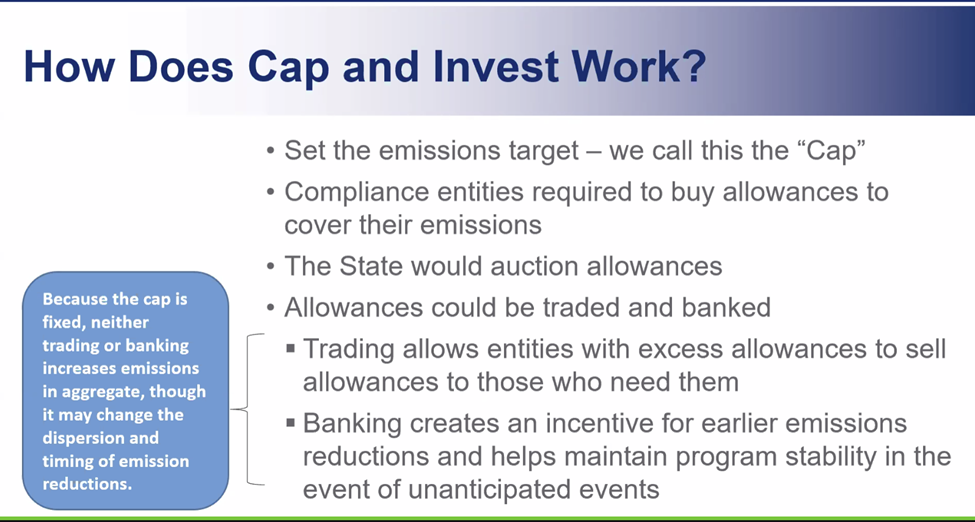
The next slide in this series explained that when a cap-and-invest program is implemented investment decisions change. The added cost of the allowances makes “Investment in pollution reductions become cost effective because it’s cheaper to cut those emissions than purchase allowances (yellow wedge)”. In my opinion, however, the incremental costs of the allowance price necessary to make those investments cost-effective is higher than what is politically acceptable. I guessed that that in order to make the emission reductions needed investments between $15.5 and $46.4 billion per year will be required. I don’t think that range is politically palatable. The slide also pointed out that proceed investments can be used to reduce emissions so that decision-makers will have “even more of an incentive to choose to invest in decarbonization (orange wedge).”
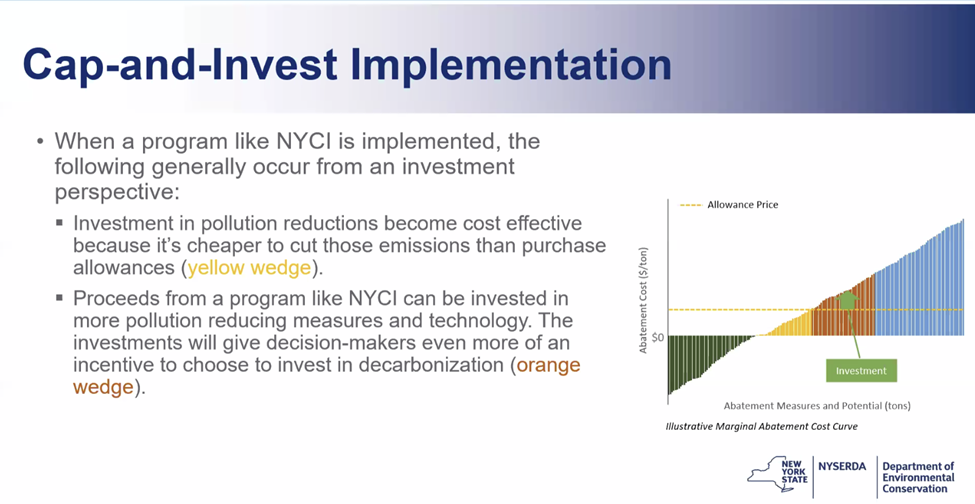
The next slide addressed flexibility mechanisms that are included to address unforeseen circumstances. They are proposing to include price stability features included in RGGI: a price floor, emissions containment reserve, and a cost containment reserve. They explain that they are:
“intended to make the system resilient to unexpected changes—sharp and unanticipated emission reductions (e.g., the transition away from coal) or energy shocks (e.g., as witnessed during COVID-19).” The slide emphasizes the price ceiling explaining that “If clean energy technology faces substantial barriers (supply chain issues, inadequate workforce, unavailable mitigation options, etc.)” that without some restrictions that costs could explode. The proposed solution is “a price ceiling where unlimited compliance instruments are issued at a predetermined price.” This limits emission reductions temporarily until the market catches up. These allowance are explicitly created just for this compliance requirement. That ensures that facilities will not shut down because they don’t have sufficient allowances. Among the many unresolved issues is what that means to the Climate Act targets. If they have exceed the limit but kept the lights on and did not induce an artificial energy shortage that is a good thing. But the climate activists will have a fit.
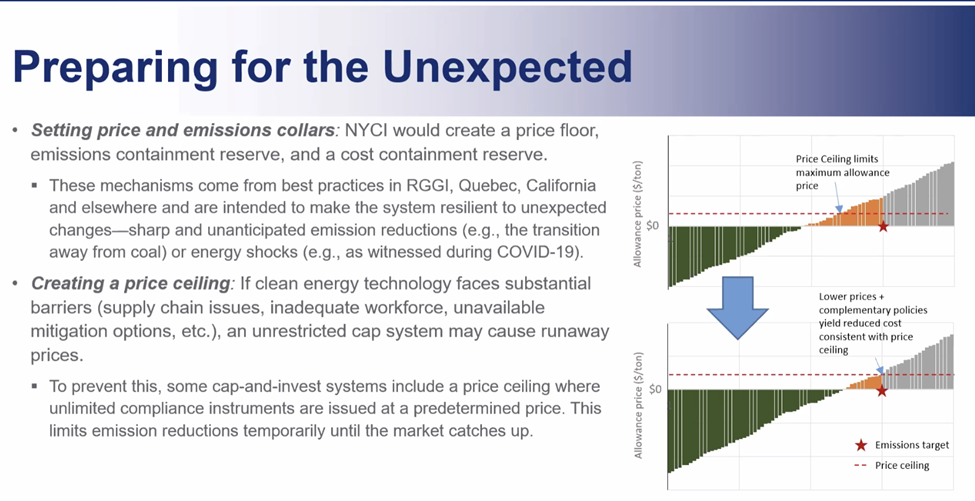
The next slide addresses a fundamental issue of a single jurisdiction GHG emissions reduction program intended to address a global problem. When New York acts alone its programs can cause “leakage” i.e., “shifting activity out of New York and to other locations with higher emissions.” New York industry is already among the most efficient in the country which makes further improvements more costly and reduces the potential total reductions. The NYCI pre-proposal recommends “providing no-cost allowances to industry at risk of leakage in amounts that decline every year”. This sounds fine in theory but in practice I suspect it will not be very effective.
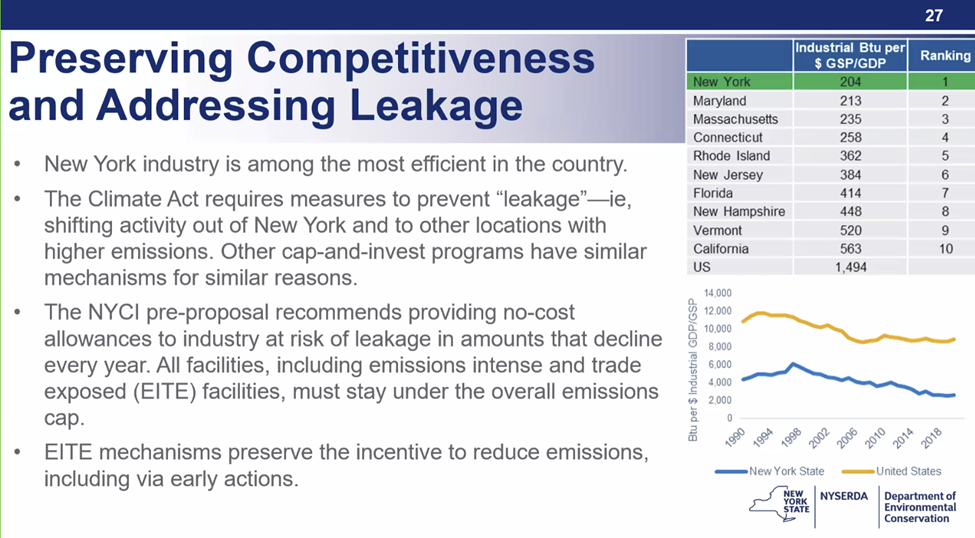
Hillel Hammer (NYSERDA) read the script for the “Current Emissions” section of the webinar. This session set the stage for the Preliminary Analysis Overview webinar later in the week. That analysis is supposed to cover emissions and costs. Environmental Justice advocates have created a story that peaking power plants in New York City are “perhaps the most egregious energy-related example of what environmental injustice means today” and are demanding that they be shut down as soon as possible, The single-minded focus on the evils of these facilities extends to demands that NYCI not increase emissions within disadvantaged communities (DACs) near the power plants. According to the script inhalable particulate (PM2.5) emissions are primarily from other sources. The following slide shows that “Individually controlled (permitted) stationary sources, including electric generation units, large industrial sources, and large commercial and institutional sources represented approximately 4% of the total.”

The next slide describes the sources that create inhalable air pollution burdens in New York. It points out that:
- Individually controlled (permitted) stationary sources yield a minority of the air pollution emissions in New York.
- In 2020, electric generation units represented 8.5% of non-wood fuel combustion PM25 emissions in NY, and other permitted sources represented approximately 3.5%.
- Area and mobile sources dominate, which means that individual stationary source-focused policy is important but doesn’t address the bulk of sources.
The message is that addressing permitted stationary sources does not address the bulk of the problem in DACs.

The next slide addressed electricity sector emissions. It states that:
- Existing policies will go a long way to addressing sources of emissions in the electric sector.
- RGGI, the Clean Energy Standard, and other programs will substantially reduce the use of fossil fuels for our electricity needs.
- The Peaker Rule will ultimately retire the most polluting plants in New York. 35 peaking units representing 955 MW have already retired and an additional 265 MW are expected to retire in 2025.
- NYCI cannot be designed to compel the closure of individual generators, and pricing may not reduce the use of peaking facilities.
The final item bluntly points out that NYCI is the wrong tool to use to try to shut down the peaking power plants. During the presentations and in the pre-proposal outline the DEC has suggested that their preferred approach is to limit emissions from sources in DACs using permit conditions in other programs. I agree with DEC on this line of reasoning. Trying to control a local air quality problem with a GHG emissions program designed to address global impacts is absurd. However, logic and reason are not the primary drivers of the environmental justice advocates. They rely on emotion. It will be interesting to see if they accept these arguments or demand something different.

The next slide addressed transportation emissions:
• Advanced Clean Cars II and Advanced Clean Trucks will drive substantial uptake of zero emission vehicles across all classes.
• Commitments to all-electric school buses will support change for those vehicles that directly burden children.
• Investments like the Clean Transportation Prizes target market transformation in the most impactful geographies.
• NYCI would provide essential revenue and price signal to ensure achievement of existing policies in addition to advancing greater ambition.
In this slide and the previous one, the transformation claims in the bar charts are based on the Integration Analysis. Based on my evaluation of the draft Scoping Plan analyses that used the Integration Analysis I am skeptical of the emission reductions expected.
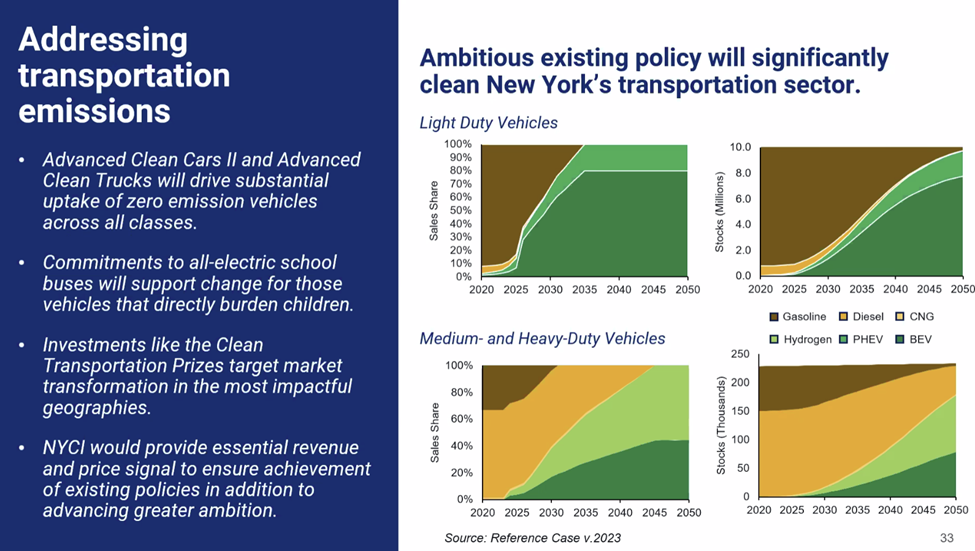
The final slide associated with the emission reduction policies claims that “NYCI will accelerate New York’s emission reduction policies and programs that advance building decarbonization”. This is where the claims deserve more attention. It says that “NYCI will put electricity on a more level playing field with fossil fuels, helping support building efficiency and electrification”. That occurs when the cost of carbon added by NYCI makes fossil fuels more expensive and reduces the present cost advantage of fossil fuels relative to electricity. It claims that “In particular, NYCI will support adoption of heat pumps, especially replacing heating oil.” However, everything I have seen suggests that heat pumps are already cost competitive with heating oil furnaces but that they are nowhere close for natural gas furnaces. The final bullet point says that “NYCI will create a new investment mechanism for building transition.” Presumably that means that revenues from the auction will subsidize building electrification.
The other section of this slide states that “NYCI will also help deploy zero emission vehicles faster than with current policies alone”:
- This is especially the case for medium and heavy-duty vehicles and non-road engines, where existing regulations are less stringent than for light duty. Diesel engines are also especially impactful in many Disadvantaged Communities.
- NYCI will even the playing field for clean transportation, and the revenue will create financial support also for hard-to-electrify vehicles, supporting not only focused investment in electrifying these impactful sources, but also growth of hydrogen fuel cell vehicles used in long- haul heavy-duty and non-road applications.
While the theory suggests, and the results may show some benefits, I do not think there will be meaningful impacts. This is another situation where the demand is inelastic, and the alternatives have so many downsides that it would take an enormously expensive carbon cost to justify meaningful conversions.

There was a session on “Delivering Equitable Benefits” but I am not going to discuss them much here. One point made does deserve mention “The Climate Act requires that DEC’s NYCI regulation not result in net increases in co-pollutant emissions or disproportionately burden disadvantaged communities”. The DEC and NYSDERDA analysis need to prove that is the case.
Conclusion
I was worried because environmental activists want to remove certain components that have made similar trading programs work in the past. The DEC and NYSERDA proposal confronts that line of reasoning in order to preserve the expectations that NYCI will work the same as other programs.
There is an enormous effort necessary to get this program in place and operational by the end of the year. I don’t think it is possible and I suspect that there are insufficient resources at the state agencies to make it even close. Unfortunately, the likely outcome is a poorly designed and implemented program. Worse it could end up causing more problems and adding costs. Stay tuned.

